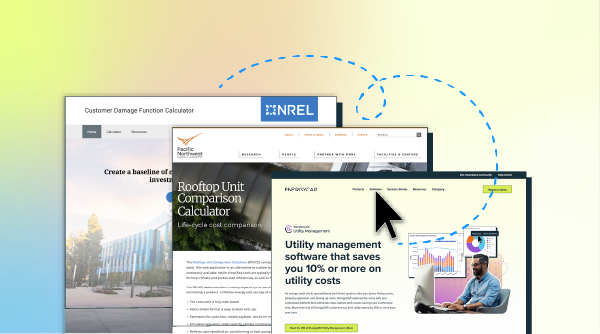Grocery stores are energy hogs, using more energy for refrigeration than any other industry in the country. But the problem isn’t just high usage, it’s hidden waste that’s buried in utility bills, override switches, outdated Building Automation System (BAS) schedules, and misaligned capital priorities.
It’s the cooler that drifts 3°F off the setpoint for weeks before someone notices. It’s HVAC units short-cycling on 95-degree days because someone overrode the economizer logic last July. It’s $20,000 in peak demand charges you couldn’t avoid because no one saw the spike coming. And the worst part? You’re probably paying for it across hundreds of locations.
If you manage energy or facilities for a grocery chain, you already know that solving these problems isn’t just about cutting kWh; it’s about protecting margin, planning smarter capital projects, and keeping stores operational while minimizing the work efforts of your facilities and operations team.
Let’s talk about how to fix it.
Step 1. Identify the grocery utility waste
There’s no shortage of flashy energy ideas: rooftop solar, LED retrofits, even sophisticated building automation controls. But most grocery stores are leaking energy, and money, in much more mundane ways:
- Refrigeration inefficiencies: Your compressors are fighting against bad defrost schedules, drifting suction pressures, or iced-over coils.
- Controls disregard: BAS setpoints get changed and never get changed back. Schedules shift with holidays and never recover. Sensors go years without calibration. Most stores already have BMS, but few use them correctly.
- HVAC neglect: Most packaged RTUs are maintained poorly. If you’re not monitoring them, they’re probably short-cycling or drifting. Controls and sequencing make or break the ROI.
- Rogue overrides: Manual modes left on by techs who didn’t tell anyone. Lighting schedules extended “just a bit.”
- Peak demand hits: 15 minutes of poor sequencing on HVAC and refrigeration equals thousands in unnecessary demand charges.
- Unprioritized CapEx: You’re retrofitting stores based on age or anecdote, not data.
None of these factors show up in your monthly variance report. They don’t trigger alarms. But they’re there, straining your budget one kWh at a time.
Step 2. Tap into your utility data for savings
The key to stopping hidden waste is using the utility data you already have. Interval data (from smart meters or AMI feeds) shows you when load starts to drift, which stores spike during shoulder hours, and which sites keep low baseloads all night long. When paired with your building metadata like square footage, system types, BAS installs, and weather zone. Combined, these data points can answer essential questions:
- Which stores are using more energy per square foot than their peers?
- Which sites are peaking at the wrong time of day?
- Which capital projects will yield the fastest ROI?
- Which overrides are costing you thousands per month without raising red flags?
A great place to start is gathering your monthly billing data, ongoing emissions tracking, and interval data together. But here’s the catch: utility data is messy, fragmented, and hard to use unless you’ve got the right system in place. And if that place is a spreadsheet, it’s extremely difficult to get meaningful insights from the information you have.
Step 3. Use advanced energy management software like EnergyCAP
This is where advanced energy management software (EMS) comes in. EnergyCAP Utility Management takes the utility data you’re already collecting and turns it into a decision-making tool for both finance and facilities. EnergyCAP allows for:
- Utility bill management: Centralize and verify bills across hundreds of meters and dozens of utilities. Catch billing errors, track usage trends, and tie every kWh to a GL account.
- Interval data analytics: See load curves across your entire portfolio, and identify nighttime bleed, demand spikes, and drifted schedules with visuals and alerts, not buried in reports.
- Measurement and Verification (M&V): Prove the impact of retrofits and behavior changes, set baselines, and show stakeholders what’s working.
- Capital planning: Prioritize projects by data, not gut. Know which stores to target next, and what the payback will be before you spend a dollar.
- Sustainability reporting: If GHG goals are part of your scorecard (or your board’s), EnergyCAP Carbon Hub quantifies Scope 1, 2, and 3 emissions to track and report progress without ever leaving your energy management platform.
Next steps for financial and facilities leaders
If you’re in finance, you’re already watching margin erosion from inflation, consumer changes, and inventory shrink. Energy might feel like a fixed cost, but it’s not. Hidden waste is a controllable cost once you have visibility.
If you’re on the facilities or energy team, you need better tools. You could be sitting on years of utility data that will help you run leaner, catch issues faster, and plan smarter. But you need to centralize and visualize it in a useful way.
Together, you should be asking:
- Where is our portfolio underperforming?
- How do we fix the right problems first?
- Can we prove savings in dollars, not just kWh?
- How do we scale that across 50, 500, or 1,000 stores?
If your current systems can’t answer those questions, EnergyCAP can.
Bottom line: stop guessing, start managing
Hidden waste is eating your grocery margins: drifted setpoints, overrides, and poor sequencing that go undetected. Use interval data alongside bills and emissions in one system to spot issues fast, control demand charges, and prioritize projects that bring down your utility bills.
Start by gathering 12–24 months of your utility bills, and use our free benchmarking calculator to see how your buildings compare to other grocery retail portfolios, compare your buildings against each other, and understand your Energy Use Intensity. Then, give us a call to start your journey to lower utility bills.



![Top 12 sustainability reporting platforms (ESG) [2026]](https://www.energycap.com/wp-content/uploads/2025/11/blog_thumb_top-sustainability-platforms.webp)